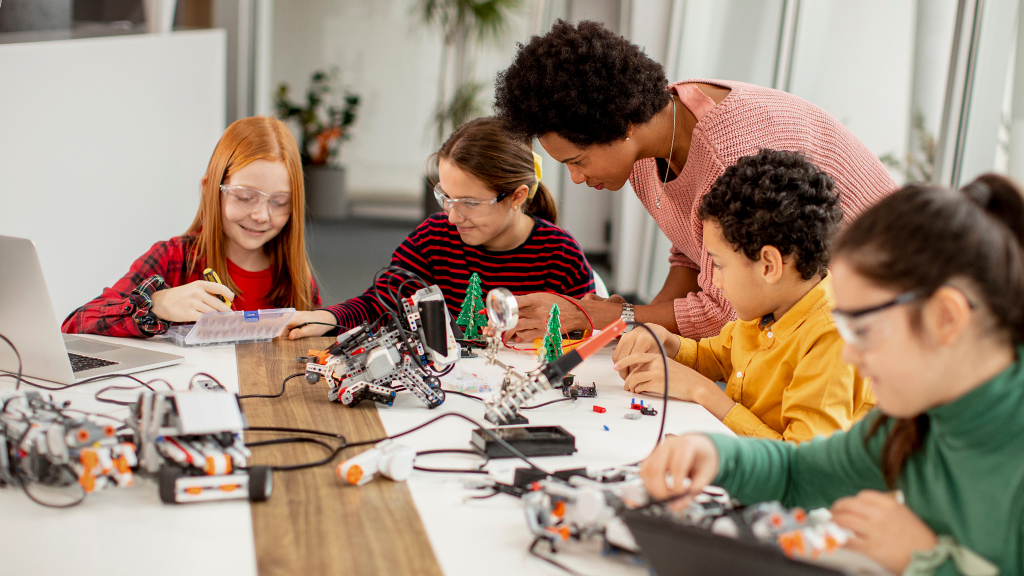Research Worth Reading
What Does It Really Mean to Integrate STEM?
By Bridget Miller, Ph.D., Michelle Dubek, Ph.D., Shannon Navy, Ph.D. and Cathrine Maiorca, Ph.D.
Posted on 2025-05-15

Disclaimer: The views expressed in this blog post are those of the author(s) and do not necessarily reflect the official position of the National Science Teaching Association (NSTA).
We hear the acronym “STEM” used all the time, but what does it actually mean to integrate science, technology, engineering, and mathematics? True STEM integration isn’t just about including all four subjects in a lesson: It’s about purposefully connecting them in a way that makes learning more authentic and meaningful for students.
According to the NSTA, integrated STEM is an instructional approach that blends concepts and practices from multiple STEM disciplines within a single learning experience. In other words, instead of teaching each subject separately, students engage in learning that naturally weaves together different STEM fields.
So what does this look like in the classroom? One of the best ways to implement integrated STEM is through project-based learning or problem-solving activities. These approaches encourage students to apply their knowledge across different STEM areas to tackle real-world challenges. Whether they’re designing a bridge, coding an app, or analyzing environmental data, students aren’t just memorizing facts: They’re thinking like scientists, engineers, and mathematicians all at once.
The key to meaningful STEM integration is intentionality. It’s not about simply adding a tech tool to a science lesson or squeezing in some math equations during an engineering project. Instead, it’s about creating learning experiences in which STEM disciplines naturally intersect, helping students build deeper understanding and real-world problem-solving skills.
Want to bring more authentic STEM integration into your classroom? Start by designing lessons that encourage students to think across disciplines, ask questions, and tackle challenges that don’t have just one right answer. That’s when real STEM learning happens!
School Science and Mathematics is a research journal focusing on integrated STEM. The following articles from School Science and Mathematics have been identified by the School Science and Mathematics Association as Research Worth Reading.
Balancing disciplinary and integrated learning: How exemplary STEM teachers negotiate tensions of practice
Every day, teachers work hard to bring meaningful learning experiences to their students to prepare them for our continuously changing world. Integrated STEM education is one powerful way to inspire active, hands-on, personally relevant learning in classrooms. STEM education leverages the engineering design process to unify and apply disciplines for the purpose of designing-in-context to solve real-world problems. Integrated STEM education has the possibility and potential to enhance student motivation, resulting in deeper knowledge and skills development while connecting science learning to everyday life. Despite the call to integrate STEM disciplines, teachers can face significant barriers to enacting to this pedagogical approach. This study aimed to give voice to teachers who are using this approach in their daily teaching to learn about what’s working well for them.
In the study, 14 exemplary elementary and secondary teachers shared how they operationalized integrated STEM education in their practice. Their approach to integrated STEM education engaged learners in collaboratively understanding and addressing real-world, socio-scientific issues. A common approach to STEM education centered on the engineering design process, an iterative cycle of brainstorming, planning, enacting, testing, and revising.
Through in-depth interviews, teachers shared common tensions requiring balance in their practice as they endeavored to use integrated STEM teaching as their preferred pedagogical approach:
Curriculum Content versus Skills
Teachers needed to find a balance between teaching curricular content and skills development, describing how a focus on assessing and reporting on skill development presented greater opportunity to pursue student-centered integrated STEM pedagogy. Leveraging socio-scientific issues as the fulcrum of learning provided a strong basis for both curricular and skills-based learning.Key perspective for implementation. Using socio-scientific issues to drive integrated STEM education and solve related problems using the engineering design process presents opportunities to create balanced learning of both disciplinary content and skills.
Guided Instruction versus Play
Teachers were comfortable using guided or structured instruction in their teaching; however, they stressed the importance of including ample time for play in integrated STEM education, including in secondary environments, to foster creativity, inquiry, curiosity, and innovation. Integrated STEM teachers had their fingers on the pulse of the classroom, knowing when to leverage play and when guided instruction was required to enhance specific content learning.Key perspective for implementation. Offer students time to play and explore materials used for design solutions. When needed, teachers can direct or guide instruction to ensure students understand how to use materials safely and effectively and learn about the content supporting concepts.
Process versus Task Completion
Teachers described assessment as the engine propelling integrated STEM education. In the study, teachers stressed that while final products were necessary, conversations, observations, and conferences along the way were equally important in informing planning and determining students’ final grades. Co-constructing final grades with students through conferences, considering both process and product, was a common approach to evaluation in integrated STEM classrooms.Key perspective for implementation. With risk taking and failure central to the engineering design process, students need to recognize the learning comes through risk and failure. Importantly, teachers need to ensure that students are not penalized on assessments for taking risks with their learning. Teachers can offer students ample time to test and subsequently improve their designs, encouraging them to record their thinking along the way. Learning logs or portfolios can be used as sources of evidence that students may draw upon to describe and defend their suggested grades during co-constructed evaluations.
Collaboration versus Individual Needs
Working together is a hallmark of integrated STEM education. An inclusive integrated STEM classroom leverages students’ strengths, balancing the needs of individual students while developing the transferable skills of communication and collaboration.Key perspective for implementation. To support students working collaboratively, teachers stressed the importance of knowing their students’ strengths and learning needs. Specific strategies for effective collaboration included allowing students to brainstorm individually before coming together in their groups and documenting their ideas before sharing with the group. Teachers also spoke of leveraging formative assessments to ensure that student strengths were being developed. Taking the time to build a community of learners who respect and care for one another, while holding high expectations of all students, helps attain the delicate balance between collaboration and individual students’ needs.
Integrated STEM education is not without its challenges, and its implementation will look different in each teaching context. However, exemplary integrated STEM teachers showed that balancing tensions of practice can actualize the benefits of this integrated pedagogical approach for more engaged student learning. Read the complete article to learn more from these exemplary teachers.
For more information and sources, see Dubek, M., N. Rickey, and C. DeLuca. 2024. Balancing disciplinary and integrated learning: How exemplary STEM teachers negotiate tensions of practice. School Science and Mathematics 124 (4): 249–265.
PBL as a pedagogical approach for integrated STEM: Evidence from prospective teachers
Integrating science, technology, engineering, and mathematics (STEM) into K–12 curricula has become a popular goal in many school communities. However, there are often few supports in place to help teachers enact this type of integrated instruction. Furthermore, teachers often do not experience integrating content areas or integrated curriculum in their own preparation programs. Therefore, implementing integrated STEM instruction can be a challenge, especially for those new to the teaching profession.
This 2020 study by researchers at Kent State University investigated how problem-based learning (PBL) can be used as a pedagogical approach for integrating STEM in elementary classrooms. The participants were prospective elementary teachers who learned about problem-based learning and integrated STEM in their elementary science methods course at the university before designing their own PBL units. The findings revealed that all of the PBL units integrated at least two of the four STEM disciplines, with 25% of the units fully integrating all four STEM disciplines and 38% integrating three of the four STEM disciplines. In addition, all of the PBL units integrated literacy and science, and some units included other non-STEM disciplines such as social studies, art, and business. On average, the PBL units integrated 4.8 different content areas per unit. This provides evidence that PBL is a pedagogical approach that can integrate STEM as well as other disciplines in elementary classrooms.
Based on the findings, the researchers recommend that teachers consider using PBL in elementary classrooms. Teacher educators can incorporate PBL and integrated STEM instruction in methods courses, and professional development specialists can include these approaches in program development. This PBL approach can help schools and classrooms achieve the goal of integrated STEM.
For more information, see Navy, S., and F. Kaya. 2020. PBL as a pedagogical approach for integrated STEM: Evidence from prospective teachers. School Science and Mathematics120 (5): 285–296.
Elementary preservice teachers’ integration of engineering into STEM lesson plans
The Research
As a society dependent on STEM, providing opportunities for our students to engage in engineering design challenges will become increasingly more important in schools, presenting both opportunities and challenges for us as educators. Research shows that STEM integration benefits students; it can improve learning outcomes, help students become better problem solvers, and prepare them to find solutions to complex interdisciplinary problems. However, many teachers haven’t received adequate support in designing instruction that meaningfully integrates STEM, particularly engineering.
In a qualitative study published in School Science and Mathematics, researchers examined how elementary preservice teachers created integrated STEM lesson plans that incorporated authentic engineering problems. The researchers analyzed 16 lesson plans designed by preservice teachers enrolled in a mathematics methods course, using the Quality K–12 Engineering Education Framework to identify engineering characteristics in their lessons.
Key Findings
The study found that 15 of 16 preservice teachers demonstrated at least an emerging ability to create integrated STEM lessons that contained engineering elements. Their lessons included engineering problems with constraints, prototype or model development, model testing, and data collection and analysis related to the model. The most effective lesson plans included real-world contexts and authentic problems for students to tackle. For instance, one preservice teacher developed a lesson in which students were “hired to design the next tallest roller coaster at Six Flags Magic Mountain.” This provided a meaningful context for the engineering challenge. While most preservice teachers successfully integrated engineering and mathematics into their lessons, integrating science presented more challenges. Some lesson plans only included science concepts but failed to address specific science standards. In contrast, other lessons missed the opportunity to address science altogether. Only three participants integrated all three content areas (science, engineering, and mathematics) in their lesson plans.
Key Takeaways for Your Classroom
Create Authentic Tasks
Frame engineering activities in real-world contexts that matter to students. Instead of simply asking students to “build a tower,” challenge them to design a tower that could withstand the wind conditions in your local area or create a structure that could serve as a wildlife observation platform for a nearby park. These authentic contexts help students understand why engineering work matters and will make it easier to see how STEM is valuable in the world around them.
Incorporate the Engineering Design Process
Guide students through all phases of engineering design: problem identification, background research, planning approaches, brainstorming multiple solutions, creating prototypes, testing, data collection, and redesign. Be sure to set aside enough time for students to experience multiple iterations of testing and improving their designs, as this reinforces the idea that failure is part of the learning process.
Make Explicit Connections Across Disciplines
Connect the science and mathematics topics in the engineering challenge to the content you have covered with your students. For example, when designing balloon-powered cars, you can connect this challenge to force and motion concepts in science and/or measurement standards in mathematics. To help students better communicate using appropriate science and math vocabulary, you can create a word wall with relevant science and math vocabulary that students can see during the engineering challenge.
Structure Effective Teamwork
Assign specific roles within engineering teams (materials manager, recorder, tester, and so on) and rotate these roles across projects. Create structured protocols for brainstorming that ensure all students contribute ideas. Use engineering notebooks in which students can document their thinking, record data, and reflect on their learning throughout the design process.
Assessments That Value Process and Product
Create assessments that evaluate the process that students use to find solutions, as well as their final solution. This can be done by including 21st-century skills in the rubric and how well the final product meets the criteria and constraints unique to the problem. You can also include opportunities for students to present their designs to authentic audiences like other classes, school administrators, or community members to emphasize communication aspects of engineering design.
By engaging elementary students in authentic tasks, they use the engineering design process to find solutions to problems in contexts that matter to them. Teachers can easily integrate science, mathematics, and technology; develop students’ problem-solving skills; and help students recognize how STEM can solve problems in the world.
For more information, see Maiorca, C., and M. Mohr-Schroeder. 2020. Elementary preservice teachers’ integration of engineering into STEM lesson plans. School Science and Mathematics 120 (7): 402–412.
 Dr. Bridget Miller is the Co-editor of School Science and Mathematics and a professor of Science Education at the University of South Carolina, Columbia. Dr. Miller began at the University of South Carolina in 2013 after obtaining her Ph.D. in Educational Studies at Purdue University.
Dr. Bridget Miller is the Co-editor of School Science and Mathematics and a professor of Science Education at the University of South Carolina, Columbia. Dr. Miller began at the University of South Carolina in 2013 after obtaining her Ph.D. in Educational Studies at Purdue University.
 Dr. Michelle Dubek is an Associate Professor, Teaching Stream, in the Department of Curriculum, Teaching and Learning at the Ontario Institute for Studies in Education. Her research focuses on STEAM education and assessment within interdisciplinary learning contexts. Dr.Dubek teaches Science and Environmental Education foundation courses.
Dr. Michelle Dubek is an Associate Professor, Teaching Stream, in the Department of Curriculum, Teaching and Learning at the Ontario Institute for Studies in Education. Her research focuses on STEAM education and assessment within interdisciplinary learning contexts. Dr.Dubek teaches Science and Environmental Education foundation courses.
 Dr. Shannon Navy is an Associate Professor at Kent State University. Her work is influenced by impacting the lives of science teachers and students. She conducts research on the development of teacher resilience through the acquisition of quality resources, social media as a curriculum resource for teachers, and STEM integration and pedagogy in K-12 classrooms.
Dr. Shannon Navy is an Associate Professor at Kent State University. Her work is influenced by impacting the lives of science teachers and students. She conducts research on the development of teacher resilience through the acquisition of quality resources, social media as a curriculum resource for teachers, and STEM integration and pedagogy in K-12 classrooms.
 Dr. Cathrine Maiorca is an Assistant Professor in Elementary Mathematics at California State University, Northridge. She received her Ph.D. in 2016 from the University of Nevada, Las Vegas. Her work focuses on integrated STEM and STEM equity.
Dr. Cathrine Maiorca is an Assistant Professor in Elementary Mathematics at California State University, Northridge. She received her Ph.D. in 2016 from the University of Nevada, Las Vegas. Her work focuses on integrated STEM and STEM equity.
Note: The NSTA Research Committee is here to help you stay informed about the latest research in science education. Watch for our quarterly Research Worth Reading blog posts, or subscribe to NSTA’s research listserv.
The mission of NSTA is to transform science education to benefit all through professional learning, partnerships, and advocacy.


